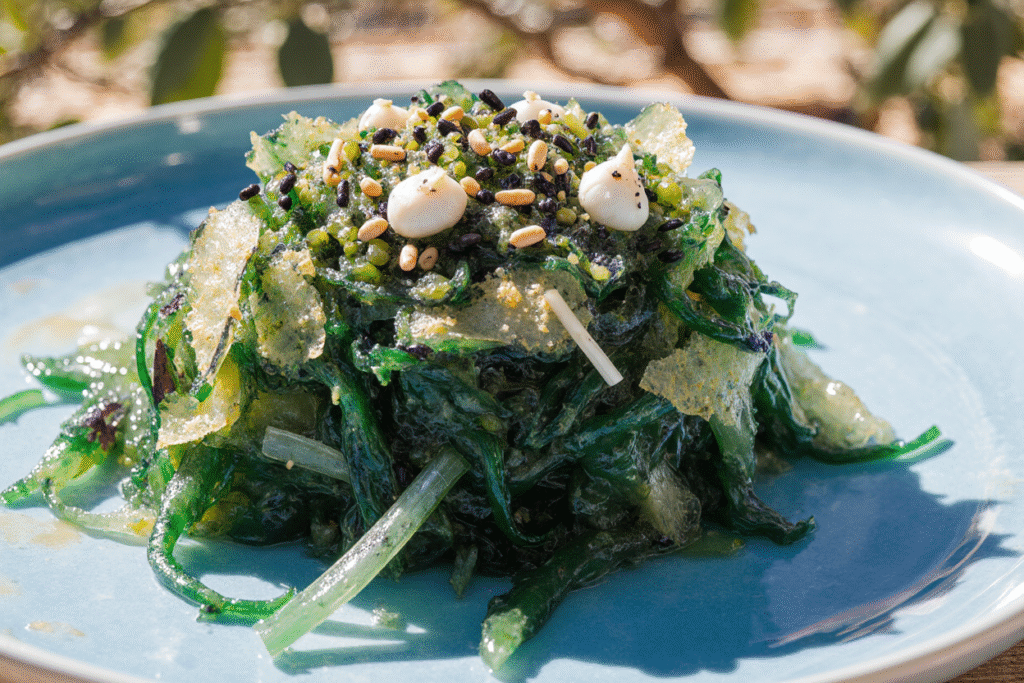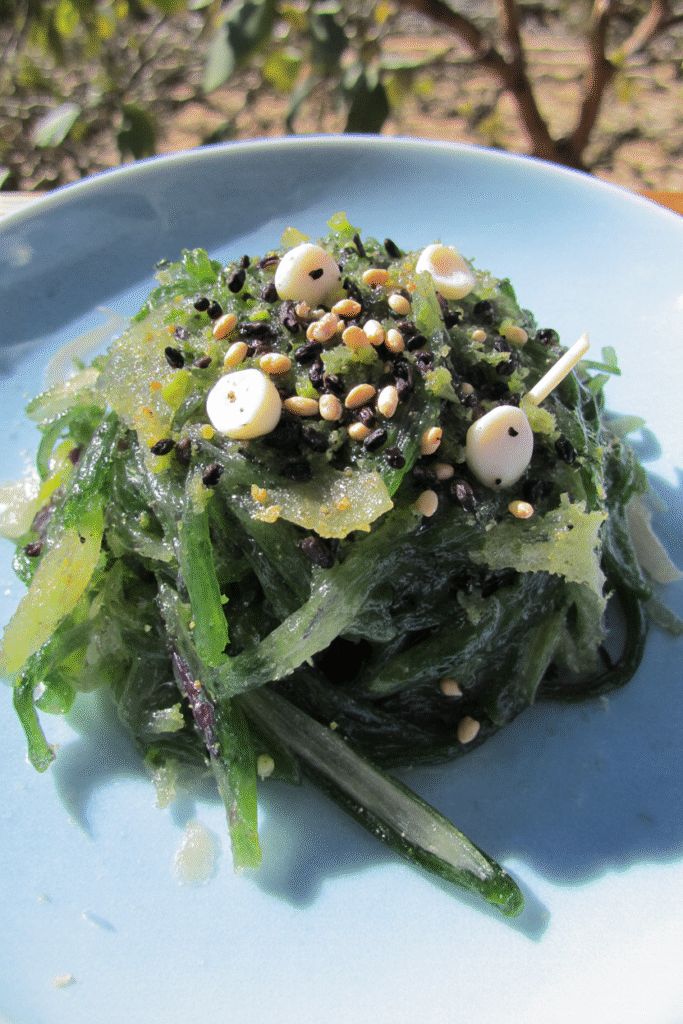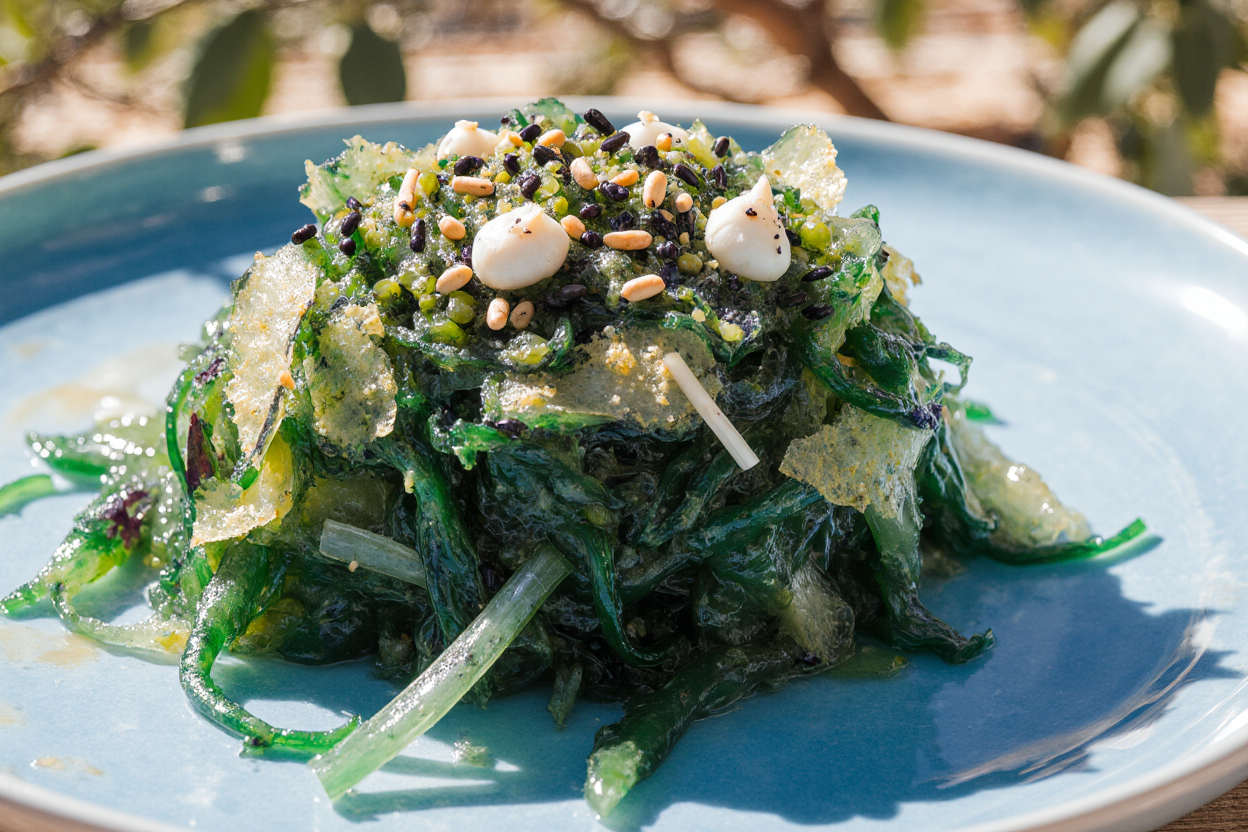
Seaweed Salad Recipe is a light, flavorful, and nutrient-rich dish often served in Japanese restaurants but easy to make at home. Its vibrant green color, fresh ocean taste, and slightly chewy texture make it a unique and refreshing side dish. Made with rehydrated wakame seaweed, sesame oil, rice vinegar, soy sauce, and sesame seeds, it’s a perfect blend of savory, tangy, and nutty flavors.
Not only is it delicious, but it’s also loaded with minerals like iodine, calcium, and magnesium, plus antioxidants that support overall health. Whether enjoyed with sushi, grilled fish, or as part of a poke bowl, this quick and versatile salad is a healthy addition to any meal.
Why You’ll Love This Seaweed Salad Recipe
This seaweed salad is packed with flavor and nutrition while being quick and easy to prepare. In just minutes, you can create a restaurant-quality side dish that’s vegan, low-calorie, and adaptable to your taste. The umami-rich dressing paired with tender seaweed and crunchy sesame seeds offers a satisfying bite every time.
You’ll love how versatile it is—serve it as a light appetizer, mix it into grain bowls, or pair it with your favorite main course. Its bright color and fresh flavor also make it a beautiful, crowd-pleasing addition to any table.
What You’ll Need
- Dried wakame seaweed – 1 cup (about 25g), rehydrated before use.
- Soy sauce or tamari – 2 tablespoons (for gluten-free).
- Rice vinegar – 2 tablespoons, for tangy freshness.
- Sesame oil – 1 tablespoon, for a nutty aroma.
- Sugar – 1 teaspoon, to balance flavors.
- Sesame seeds – 1 tablespoon, toasted for crunch.
- Optional add-ins – thinly sliced cucumber, shredded carrots, or chili flakes for spice.
How to Make Seaweed Salad Recipe
- Soak the seaweed – Place dried wakame in a bowl of cold water for 8–10 minutes until fully rehydrated. Drain and squeeze out excess water.
- Prepare the dressing – In a small bowl, whisk together soy sauce, rice vinegar, sesame oil, and sugar until well blended.
- Combine – Add seaweed to a mixing bowl, pour over the dressing, and toss until evenly coated.
- Finish & serve – Sprinkle with toasted sesame seeds, add optional toppings, and serve immediately or chill for 10–15 minutes for a more intense flavor.

You Must Know
The secret to great seaweed salad starts with choosing high-quality wakame. Look for vibrant green, clean-smelling dried seaweed without an overly fishy scent. Rehydrating properly is essential—over-soaking can make it mushy, while under-soaking leaves it chewy in an unpleasant way. Always drain and gently squeeze the seaweed to avoid excess water diluting your dressing.
Balance is key in the dressing. Too much soy sauce will overpower the flavor, while too little sesame oil may make it taste flat. Taste as you go, and adjust the seasoning to your preference. Also, seaweed naturally contains salt, so avoid over-seasoning before tasting the final dish.
Perfecting the Cooking Process
Even though this is a no-cook recipe, a few small steps can elevate your seaweed salad. Toast your sesame seeds in a dry pan for 1–2 minutes to bring out their nutty aroma. If adding vegetables like cucumber or carrots, slice them thinly so they blend well with the seaweed strands.
Chilling the salad for 10–15 minutes before serving allows the flavors to meld and makes the texture more refreshing. If you’re making it ahead, store the dressing separately and mix just before serving to keep the seaweed’s texture intact. With these small tweaks, you’ll have a salad that tastes just like the one from your favorite Japanese restaurant—if not better.
Add Your Touch Seaweed Salad Recipe
Seaweed salad is easy to customize, so feel free to get creative. For extra crunch, mix in thinly sliced radish or bell peppers. If you like spice, add a pinch of red pepper flakes or a drizzle of sriracha. A sprinkle of fresh herbs like cilantro or green onions can give it a fresh twist, while diced avocado adds creaminess.
You can also switch up the dressing—try adding a touch of grated ginger for warmth, or a squeeze of fresh lemon or lime for brightness. The beauty of this dish is that it works well with both traditional Japanese flavors and fusion-inspired twists.
Storing & Reheating
Warm up with our hearty and comforting soup recipes
Seaweed salad keeps well in the refrigerator for up to 3 days. Store it in an airtight container to maintain freshness. If the salad releases excess liquid after sitting, simply drain it before serving and refresh with a small splash of dressing.
Since it’s a cold dish, reheating isn’t necessary—just give it a quick toss before serving. If you’ve stored the dressing separately, combine it with the seaweed just before eating to preserve the best texture and flavor.
Chef’s Helpful Tips for Seaweed Salad Recipe
Check out more creative twists on classic comfort food
- Don’t oversoak – Wakame only needs about 8–10 minutes to rehydrate. Any longer and it can become slimy.
- Toast sesame seeds – A quick 1–2 minutes in a dry pan deepens their nutty flavor.
- Taste before salting – Seaweed is naturally salty, so you may not need extra salt.
- Chill for flavor – Let the salad rest in the fridge for 10–15 minutes so the dressing fully infuses.
- Cut for easy eating – If your wakame comes in large pieces, chop it into bite-size lengths after soaking.
FAQ for Seaweed Salad Recipe
Can I use fresh seaweed instead of dried?
Yes, but dried wakame is easier to store and has a more concentrated flavor. Fresh seaweed should be rinsed and blanched briefly before use.
Find more light and healthy recipes perfect for busy days
Is seaweed salad healthy?
Absolutely—it’s low in calories and rich in minerals, antioxidants, and fiber, making it a great choice for a nutrient-packed side.
Can I make it ahead of time?
Yes, but for best texture, store the dressing separately and mix just before serving.
What can I serve with it?
It pairs beautifully with sushi, grilled fish, teriyaki chicken, or poke bowls.
Conclusion
Seaweed salad is proof that simple ingredients can create big flavor and impressive nutrition. With its fresh, tangy dressing and tender yet slightly chewy texture, it’s a dish that works for everyday meals or special occasions. It’s quick to make, endlessly customizable, and pairs well with a variety of main courses—from sushi and poke bowls to grilled meats and vegetarian plates.
By mastering the basics—rehydrating seaweed properly, balancing the dressing, and adding your own creative touches—you’ll have a go-to recipe that’s both healthy and delicious. Whether you’re preparing it as a light appetizer, a side for dinner, or a colorful addition to a party spread, this salad will always bring a refreshing pop of flavor to the table.
Now that you know the tips, tricks, and variations, it’s time to bring the flavors of the ocean to your kitchen and enjoy a restaurant-quality seaweed salad anytime you crave it.

Homemade Seaweed Salad Recipe – Better Than Takeout
Description
A fresh, tangy, and nutrient-packed Japanese-inspired salad made with wakame seaweed, sesame oil, and rice vinegar—perfect as a light appetizer or sushi side.
Ingredients
Instructions
Rehydrate seaweed – Soak dried wakame in cold water for 8–10 minutes. Drain well and gently squeeze out excess water.
Make dressing – In a small bowl, whisk soy sauce, rice vinegar, sesame oil, and sugar until dissolved.
Combine – Toss seaweed with dressing until coated.
Finish & serve – Sprinkle with sesame seeds, add optional toppings, and chill for 10 minutes before serving for best flavor.
Notes
- Do not oversoak seaweed—it can become mushy.
Toast sesame seeds for a richer, nutty aroma.
Adjust sugar, vinegar, or soy sauce to taste.
Best served fresh but can be stored for up to 3 days in the fridge.

